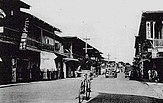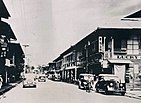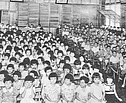Japanese diaspora
日系人 Nikkeijin | |
|---|---|
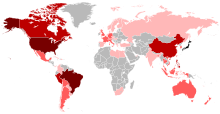 | |
| Total population | |
| About 4,000,000 (2022)[1] | |
| Regions with significant populations | |
| Brazil | 2,000,000[2] (2022) |
| United States | 1,550,875[3] (2020) |
| Canada | 129,425[4] (2021) |
| Philippines | 120,000[5][6][better source needed] |
| Peru | 103,182[7] (2021) |
| China | 102,066[8] (2022)note |
| Australia | 94,942[8] (2022)note |
| Mexico | 86,143[9] (2022) |
| Thailand | 78,431[8] (2022)note |
| Argentina | 76,440[10] (2020) |
| United Kingdom | 65,022[8] (2022)note |
| Germany | 42,266[8] (2022)note |
| South Korea | 41,717[8] (2022)note |
| France | 36,104[8] (2022)note |
| Singapore | 32,743[8] (2022)note |
| Malaysia | 24,545[8] (2022)note |
| Vietnam | 21,819[8] (2022)note |
| Taiwan | 20,345[8] (2022)note |
| Micronesia | 20,000[11][better source needed] (2018) |
| Related ethnic groups | |
| Ryukyuan diaspora | |
Note: For this country, only the number of residents with Japanese nationality is shown, since the number of naturalized Japanese people and their descendants is unknown. | |
The Japanese diaspora and its individual members, known as Nikkei (Japanese: 日系, IPA: [ɲikkeː]) or as Nikkeijin (Japanese: 日系人, IPA: [ɲikkeꜜːʑiɴ]), comprise the Japanese emigrants from Japan (and their descendants) residing in a country outside Japan. Emigration from Japan was recorded as early as the 15th century to the Philippines,[12][13][14][15] but did not become a mass phenomenon until the Meiji period (1868–1912), when Japanese emigrated to the Philippines[16] and to the Americas.[17][18] There was significant emigration to the territories of the Empire of Japan during the period of Japanese colonial expansion (1875–1945); however, most of these emigrants repatriated to Japan after the 1945 surrender of Japan ended World War II in Asia.[19]
According to the Association of Nikkei and Japanese Abroad, about 4 million Nikkei live in their adopted countries.[1] The largest of these foreign communities are in Brazil, the United States, the Philippines,[20] China, Canada and Peru. Descendants of emigrants from the Meiji period still maintain recognizable communities in those countries, forming separate ethnic groups from Japanese people in Japan.[21] The largest of these foreign communities are in the Brazilian states of São Paulo and Paraná.[citation needed] There are also significant cohesive Japanese communities in the Philippines, Peru and in the American state of Hawaiʻi.[citation needed] Nevertheless, most emigrant Japanese are largely assimilated outside of Japan.[citation needed]
As of 2022[update], the Japanese Ministry of Foreign Affairs reported the five countries with the highest number of Japanese expatriates as the United States (418,842), China (102,066), Australia (94,942), Thailand (78,431) and Canada (74,362).[8]
Terminology
[edit]The term Nikkei, from the Japanese word nikkei (日系, lit. "of Japanese lineage"), is often used to refer to Japanese people who emigrated from Japan and their descendants.[22] These groups were historically differentiated by the terms issei (first-generation Nikkei), nisei (second-generation Nikkei), sansei (third-generation Nikkei) and yonsei (fourth-generation Nikkei). In this context emigration refers to permanent settlers, excluding transient Japanese abroad, although the term may not strictly relate to citizenship status. The Japanese government defines Nikkei people as foreign citizens with the ability to provide proof of Japanese lineage within three generations. On the other hand, in the United States and some other places where Nikkei people have developed their own communities and identities, first-generation Japanese immigrants with Japanese citizenship tend to be included if they are involved in the local community.[23]
The Japanese American National Museum, based upon a collaborative project that involved more than 100 scholars from 10 countries, has defined Nikkei as follows:
We are talking about Nikkei people - Japanese emigrants and their descendants who have created communities throughout the world. The term Nikkei has multiple and diverse meanings depending on situations, places, and environments. Nikkei also include people of mixed racial descent who identify themselves as Nikkei. Native Japanese also use the term Nikkei for the emigrants and their descendants who return to Japan. Many of these Nikkei live in close communities and retain identities separate from the native Japanese.[24]
Early history
[edit]Japanese emigration to the rest of Asia was noted as early as the 15th century to the Philippines;[13][25] early Japanese settlements included those in Lingayen Gulf, Manila, the coasts of Ilocos and in the Visayas when the Philippines was under the influence of Srivijaya and Majapahit Empire. In 2009, Japanese and Filipino archaeologists, from the Sumitomo Foundation-funded Boljoon Archaeological Project conducted by the University of San Carlos with the National Museum of the Philippines, discovered ancient Japanese pottery that is believed to have been in existence since the early 1700s. The ancient Japanese pottery that was discovered there has proven that there was trading activity between Japan and Cebu Island Philippines going back to the 16th century.[26] In the 16th century the Japanese settlement was established in Ayutthaya, Thailand[27] and in early 17th century Japanese settlers was first recorded to stay in Dutch East Indies (now Indonesia). A larger wave came in the 17th century, when red seal ships traded in Southeast Asia and Japanese Catholics fled from the religious persecution imposed by the shōguns and settled in the Philippines, among other destinations. Many of them also intermarried with the local Filipina women (including those of pure or mixed Chinese and Spanish descent), thus forming the new Japanese-Mestizo community.[28] In the 16th and 17th centuries, thousands of traders from Japan also migrated to the Philippines and assimilated into the local population.[29] In the 15th century AD, shimamono tea-jars were bought by the shōguns to Uji in Kyoto from the Philippines by merchants such as Luzon Sukezaemon which was used in the Japanese tea ceremony.[30] In the latter half of the 16th century the Portuguese Empire purchased and sold on Japanese slaves.[31][32]
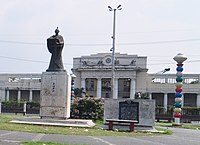
From the 15th through the early 17th century, Japanese seafarers traveled to China and Southeast Asia countries, in some cases establishing early Japantowns.[33] This activity ended in the 1640s, when the Tokugawa shogunate imposed maritime restrictions which forbade Japanese from leaving the country and from returning if they were already abroad. This policy would not be lifted for over two hundred years. Travel restrictions were eased once Japan opened diplomatic relations with Western nations. In 1867, the bakufu began issuing travel documents for overseas travel and emigration.[34]

Before 1885, fewer and fewer Japanese people emigrated from Japan, in part because the Meiji government was reluctant to allow emigration, both because it lacked the political power to adequately protect Japanese emigrants and because it believed that the presence of Japanese as unskilled laborers in foreign countries would hamper its ability to revise the unequal treaties. A notable exception to this trend was a group of 153 contract laborers who immigrated—without official passports—to Hawai'i and Guam in 1868.[35] A portion of this group stayed on after the expiration of the initial labor contract, forming the nucleus of the Nikkei community in Hawai'i. In 1885, the Meiji government began to turn to officially sponsored emigration programs to alleviate pressure from overpopulation and the effects of the Matsukata deflation in rural areas. For the next decade, the government was closely involved in the selection and pre-departure instruction of emigrants. The Japanese government was keen on keeping Japanese emigrants well-mannered while abroad in order to show the West that Japan was a dignified society, worthy of respect. By the mid-1890s, immigration companies (imin-kaisha, 移民会社), not sponsored by the government, began to dominate the process of recruiting emigrants, but government-sanctioned ideology continued to influence emigration patterns.[36]
Asia
[edit]Before 1945
[edit]In 1898, the Dutch East Indies colonial government statistics showed 614 Japanese in the Dutch East Indies (166 men, 448 women).[38] During the American colonial era in the Philippines, the Japanese population of Davao, most of whom first started out as laborers working in abaca plantations in Davao, were recorded in statistics as only numbering 30 in 1903, then 5,533 by 1920, then 12,469 by 1930, then later increased to 20,000 by 1941.[39][40] The number of Japanese laborers working in plantations rose so high that in the early 20th century, Davao City soon became dubbed as Davaokuo (in Philippine and American media) or (in Japanese: 小日本國「こにっぽんこく」, romanized: Ko Nippon Koku, lit. 'Little Japan') with a Japanese school, a Shinto shrine, and a diplomatic mission from Japan. The place that used to be "Little Tokyo" in Davao was Mintal.[41] There is even a popular restaurant called "The Japanese Tunnel", which includes a tunnel made by the Japanese in time of the war.[42]
In the Philippines, Halo-halo is believed to be an indigenized version of the Japanese kakigori class of desserts, originating from pre-war Japanese migrants into the islands.[43][44] Odong or udong of Davao Region and Visayas is inspired by Japanese udon.[45][46] During the early 1900s, there was a large community of Japanese laborers in Davao,[47] half of them Okinawans,[48] and in this period, the Japanese manufactured odong.[47]
There was also a significant level of emigration to the overseas territories of the Empire of Japan during the Japanese colonial period, including Korea,[49] Taiwan, Manchuria and Karafuto.[50] Unlike emigrants to the Americas, Japanese going to the colonies occupied a higher rather than lower social niche upon their arrival.[51]
In 1938 about 309,000 Japanese lived in Taiwan.[52] By the end of World War II, there were over 850,000 Japanese in Korea[53] and more than 2 million in China,[54] most of them farmers in Manchukuo (the Japanese had a plan to bring in 5 million Japanese settlers into Manchukuo).[55]
Over 400,000 people lived on Karafuto (Southern Sakhalin) when the Soviet offensive began in early August 1945. Most were of Japanese or Korean descent. When Japan lost the Kuril Islands, 17,000 Japanese were expelled, most from the southern islands.[56]
-
Japanese Christian in Jakarta, c. 1656
-
Japanese and Korean children, 1908–1922
-
Japanese Sunday school class in Korea, 1908–1922
-
Japanese office workers in Manila, 1930s
-
Japanese elementary school class on Saipan, 1932
-
Japanese school on Tinian, 1932
-
Japanese Buddhist temple on Etorofu, 1933
-
Japanese parade in Toyohara, 1937
-
Japanese shoppers in Taihoku, 1939
-
Japanese family in Manchukuo, 1940s
After 1945
[edit]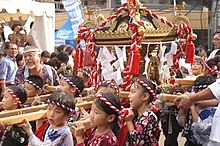
During and after World War II, most of these overseas Japanese repatriated to Japan. The Allied powers repatriated over 6 million Japanese nationals from colonies and battlefields throughout Asia.[57] Only a few remained overseas, often involuntarily, as in the case of orphans in China or prisoners of war captured by the Red Army and forced to work in Siberia.[58] During the 1950s and 1960s, an estimated 6,000 Japanese accompanied Zainichi Korean spouses repatriating to North Korea, while another 27,000 prisoners-of-war are estimated to have been sent there by the Soviet Union; see Japanese people in North Korea.[58][59]
There is a community of Japanese people in Hong Kong largely made up of expatriate businessmen. Additionally, there are 19,612 Japanese expatriates in Indonesia based mostly in the cities of Jakarta and Bali.[60]
Americas
[edit]This section needs additional citations for verification. (October 2022) |
The Japanese diaspora has been unique in the absence of new emigration flows in the second half of the 20th century.[61] However, research reports that during the post-war many Japanese migrated individually to join existing communities abroad.[62]
North America
[edit]People from Japan began migrating to the U.S. and Canada in significant numbers following the political, cultural and social changes stemming from the 1868 Meiji Restoration. (see Japanese Americans and Japanese Canadians)
Canada
[edit]
In Canada, small multi-generational communities of Japanese immigrants developed and adapted to life outside Japan.[63]
Caribbean
[edit]There was a small amount of Japanese settlement in the Dominican Republic between 1956 and 1961, in a program initiated by Dominican Republic leader Rafael Trujillo. Protests over the extreme hardships and broken government promises faced by the initial group of migrants set the stage for the end of state-supported labor emigration in Japan.[64][65]
Mexico
[edit]Mexico received Japanese immigrants in 1897,[66][67] when the first thirty five arrived in Chiapas to work on coffee farms. Immigration into Mexico died down in the following years, but was eventually spurred again in 1903 due to the acceptance of mutually recognized contracts on immigration by both countries. Immigrants coming in the first four years of these contracts worked primarily on sugar plantations, coal mines, and railroads.[68] Japanese immigrants (particularly from the Okinawa Prefecture, including Okinawans) arrived in small numbers during the early 20th century.
United States
[edit]In the United States, particularly after the Chinese Exclusion Act of 1882, Japanese immigrants were sought by industrialists to replace Chinese immigrants. In the early years of the 20th century, anxiety about the rapid growth of cheap Japanese labor in California came to a head when in 1906, when the School Board of San Francisco passed a resolution barring children of Japanese heritage from attending regular public schools. President Roosevelt intervened to rescind the resolution, but only on the understanding that steps would be taken to put a stop to further Japanese immigration.[69] In 1907, in the face of Japanese government protests, the so-called "Gentlemen's Agreement" between the governments of Japan and the United States ended immigration of Japanese workers (i.e., men), but permitted the immigration of spouses of Japanese immigrants already in the US. The Immigration Act of 1924 banned the immigration of all but a token few Japanese, until the Immigration Act of 1965, there was very little further Japanese immigration. But afterward, the Japanese American community increased heavily.
The majority of Japanese settled in Hawaii, where today a third of the state's population are of Japanese descent and the rest in the West Coast (California, Oregon, Washington and Alaska) and Southwestern United States (Arizona, New Mexico, and adjacent parts of Colorado, Nevada, Texas, and Utah), but other significant communities are found in the Northeast (Maine, New York, New Jersey, Vermont, Massachusetts, Rhode Island, Connecticut, New Hampshire and Pennsylvania) and Midwest (Illinois, Indiana, Iowa, Kansas, Michigan, Minnesota, Missouri, Nebraska, North Dakota, Ohio, South Dakota and Wisconsin) states.
South America
[edit]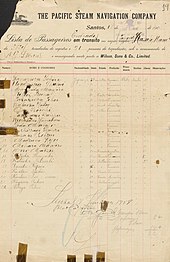
Argentina
[edit]Argentina is home to about 80,000 people of Japanese descent. Most of them live in Buenos Aires and districts like Balvanera and Monserrat have many Japanese restaurants, shops and izakayas. Buenos Aires also has the largest Japanese garden outside Japan, called Jardín Japonés, located in Palermo district.[70]
Brazil
[edit]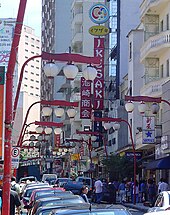
Japanese Brazilians are the largest ethnic Japanese community outside Japan (numbering about 2 million,[2] compared to about 1.5 million in the United States) and São Paulo contains the largest concentration of Japanese outside Japan. Paraná and Mato Grosso do Sul also have a large Japanese community. The first Japanese immigrants (791 people, mostly farmers) came to Brazil in 1908 on the Kasato Maru from the Japanese port of Kobe, moving to Brazil in search of better living conditions. Many of them ended up as laborers on coffee farms (for testimony of Kasato Maru's travelers that continued to Argentina see es:Café El Japonés, see also Shindo Renmei). Immigration of Japanese workers in Brazil was actually subsidized by São Paulo up until 1921, with around 40,000 Japanese emigrating to Brazil between the years of 1908 and 1925, and 150,000 pouring in during the following 16 years. The most immigrants to come in one year peaked in 1933 at 24,000, but restrictions due to ever growing anti-Japanese sentiment caused it to die down and then eventually halt at the start of World War II. Japanese immigration into Brazil actually saw continued traffic after it resumed in 1951. Around 60,000 entered the country during 1951 and 1981, with a sharp decline happening in the 1960s due to a resurgence of Japan's domestic economy.[68]
Colombia
[edit]
The Japanese Colombian colony migrated between 1929 and 1935 in three waves. Their community is unique in terms of their resistance against the internal conflict occurring in Colombia during the decade of the 1950s, a period known as La Violencia.[71]
Peru
[edit]Japanese Peruvians form another notable ethnic Japanese community with an estimated 6,000 Issei and 100,000 Japanese descendants (Nisei, Sansei, Yonsei), and including a former Peruvian president, Alberto Fujimori. Japanese food known as Nikkei cuisine is a rich part of Peruvian-Japanese culture, which includes the use of seaweed broth and sushi-inspired versions of ceviche.[72][73] As a result of Peru's gastronomic revolution and global gastrodiplomacy campaign, Nikkei is now recognized among international culinary networks as a cuisine that is uniquely a fusion of Japanese and Peruvian influences. This change has created revenues for Japanese-Peruvian communities in Lima and enabled Nikkei chefs to open up restaurants in other metropolitan cities around the world.[74]
Europe
[edit]This section needs expansion. You can help by adding to it. (June 2008) |
In recent years, many young Japanese have been migrating from Japan to Britain to engage in cultural production and to become successful artists in London.[75]
There are also small numbers of Japanese people in Russia some whose heritage date back to the times when both countries shared the territories of Sakhalin and the Kuril Islands; some Japanese communists settled in the Soviet Union, including Mutsuo Hakamada, the brother of former Japanese Communist Party chairman Satomi Hakamada, whose daughter Irina Hakamada is a notable Russian political figure.[76] The 2002 Russian census showed 835 people claiming Japanese ethnicity (nationality).[77]
There is a sizable Japanese community in Düsseldorf, Germany[78] of nearly 8,400 (as of 2018[update]) Japanese nationals (not ethnics).[79] Many of them are expatriates who stay there only for a few years.[80]
Oceania
[edit]Early Japanese immigrants were particularly prominent in Broome, Western Australia, where until the Second World War they were the largest ethnic group, who were attracted to the opportunities in pearling. Several streets of Broome have Japanese names, and the town has one of the largest Japanese cemeteries outside Japan. Other immigrants were involved in the sugar cane industry in Queensland. During the Second World War, the Japanese population was detained and later expelled at the cessation of hostilities. The Japanese population in Australia was later replenished in the 1950s by the arrival of 500 Japanese war brides, who had married AIF soldiers stationed in occupied Japan. In recent years, Japanese migration to Australia, largely consisting of younger age females, has been on the rise.[81]
There is also a small but growing Japanese community in New Zealand, primarily in Auckland and Wellington.
In the census of December 1939, the total population of the South Seas Mandate was 129,104, of which 77,257 were Japanese. By December 1941, Saipan had a population of more than 30,000 people, including 25,000 Japanese.[82] There are Japanese people in Palau, Guam and Northern Mariana Islands.
Return migration to Japan
[edit]In the 1980s, with Japan's growing economy facing a shortage of workers willing to do so-called three K jobs (きつい, kitsui [difficult], 汚い, kitanai [dirty] and 危険, kiken [dangerous]), Japan's Ministry of Labor began to grant visas to ethnic Japanese from South America to come to Japan and work in factories. The vast majority—estimated at 300,000—were from Brazil, but there is also a large population from Peru and smaller populations from other South American countries.
As a response to the Great Recession, the Japanese government offered ¥300,000 ($3,300) for unemployed Japanese descendants from South America to return to their country of origin with the stated goal of alleviating the country's worsening labor shortage. Another ¥200,000 ($2,200) is offered for each additional family member to leave.[83] Emigrants who took this offer were not allowed to return to Japan with the same privileged visa with which they had entered the country.[84] Arudou Debito, columnist for English-language newspaper The Japan Times, denounced the policy as "racist" as it only offered Japanese-blooded foreigners who possessed the special "person of Japanese ancestry" visa the option to receive money in return for repatriation to their home countries.[84] Some commentators also accused it of being exploitative since most nikkei had been offered incentives to immigrate to Japan in 1990, were regularly reported to work 60+ hours per week, and were finally asked to return home when the Japanese became unemployed in large numbers.[84][85] At the same time, return migration to Japan, along with repatriation to their home countries, has also created complex relationships with both their homeland and hostland, a condition which has been called a "'squared diaspora' in which the juxtaposition of homeland and hostland itself becomes questionable, instable and fluctuating."[86][clarification needed] This has also taken on new forms of circular migration as first and second generation nikkei travel back and forth between Japan and their home countries.[87]
Major cities with significant populations of Japanese nationals
[edit]- Los Angeles, United States: 68,595
- Bangkok, Thailand: 57,486
- Shanghai, China: 41,756
- New York City, United States: 40,496
- Singapore: 36,797
- Sydney, Australia: 34,679
- Greater London, United Kingdom: 34,125
- Vancouver, Canada: 27,962
- Hong Kong, 24,205
- Honolulu, United States: 21,329
- Melbourne, Australia: 20,175
- San Francisco, United States: 19,997
- San Jose, United States: 16,008
- Seoul, South Korea: 14,920
- Toronto, Canada: 14,160
- Kuala Lumpur, Malaysia: 13,502
- Paris, France: 13,152
- Taipei, Taiwan: 12,581
- Chicago, United States: 12,147
- Ho Chi Minh City, Vietnam: 11,927
- Seattle, United States: 11,355
- São Paulo, Brazil: 11,295
- Gold Coast, Australia: 10,901
- Brisbane, Australia: 10,803
- Auckland, New Zealand: 10,598
Note: The above data shows the number of Japanese nationals living overseas as of October 13, 2020, according to the Ministry of Foreign Affairs of Japan.[88]
See also
[edit]- Issei, Nisei, Sansei, Yonsei & Gosei
- Buddhist Churches of America
- Honpa Hongwanji Mission of Hawaii & Hawaii Shingon Mission
- Gedatsu Church of America
- Jodo Shinshu Buddhist Temples of Canada
- South America Hongwanji Mission
- List of Shinto shrines in the United States
- Saipan Katori Shrine
- Dom Justo Takayama
References
[edit]- ^ a b "Who are "Nikkei & Japanese Abroad"?". The Association of Nikkei and Japanese Abroad. Retrieved 22 May 2023.
- ^ a b "Japan-Brazil Relations (Basic Data)". Ministry of Foreign Affairs of Japan. Retrieved 22 May 2023.
- ^ "American Community Survey: Asian Alone or in Any Combination by Selected Groups". United States Census Bureau. Retrieved 22 May 2023.
- ^ "Ethnic or cultural origin by gender and age: Canada, provinces and territories". Statistics Canada. 26 October 2022. Retrieved 22 May 2023.
- ^ Agnote, Dario (11 October 2006). "A glimmer of hope for castoffs". The Japan Times. Archived from the original on 7 June 2011. Retrieved 9 August 2016.
- ^ Ohno, Shun (2006). "The Intermarried issei and mestizo nisei in the Philippines". In Adachi, Nobuko (ed.). Japanese diasporas: Unsung pasts, conflicting presents, and uncertain futures. Routledge. p. 97. ISBN 978-1-135-98723-7. Archived from the original on 28 September 2023. Retrieved 10 August 2016.
- ^ "Japan-Peru Relations (Basic Data)". Ministry of Foreign Affairs of Japan. Retrieved 22 May 2023.
- ^ a b c d e f g h i j k l 海外在留邦人数調査統計 [Annual Report of Statistics on Japanese Nationals Overseas] (PDF). Ministry of Foreign Affairs of Japan (in Japanese). 1 October 2022.
- ^ "Japan-Mexico Relations". Ministry of Foreign Affairs of Japan. Retrieved 22 May 2023.
- ^ "Japan-Argentina Relations (Basic Data)". Ministry of Foreign Affairs of Japan. Retrieved 22 May 2023.
- ^ Horie, Ryoichi (20 July 2018). "The Voice of the Ambassador to Micronesia". Association for Promotion of International Cooperation. Retrieved 22 May 2023.
- ^ "Ancient Japanese pottery in Boljoon town". 30 May 2011.
- ^ a b Manansala, Paul Kekai (5 September 2006). "Quests of the Dragon and Bird Clan: Luzon Jars (Glossary)".
- ^ Cole, Fay-Cooper (1912). "Chinese Pottery in the Philippines" (PDF). Field Museum of Natural History. Anthropological Series. 12 (1).
- ^ "Philippines History, Culture, Civilization and Technology, Filipino". asiapacificuniverse.com.
- ^ さや・白石; Shiraishi, Takashi (1993). The Japanese in Colonial Southeast Asia. SEAP Publications. ISBN 9780877274025.
- ^ Ministry of Foreign Affairs (MOFA), Japan: Japan-Mexico relations
- ^ Palm, Hugo. "Desafíos que nos acercan," Archived 15 April 2009 at the Wayback Machine El Comercio (Lima, Peru). 12 March 2008.
- ^ Azuma, Eiichiro (2005). "Brief Historical Overview of Japanese Emigration". International Nikkei Research Project. Archived from the original on 19 February 2007. Retrieved 2 February 2007.
- ^ Furia, Reiko (1993). "The Japanese Community Abroad: The Case of Prewar Davao in the Philippines". In Saya Shiraishi; Takashi Shiraishi (eds.). The Japanese in Colonial Southeast Asia. Southeast Asia Program, Cornell University Publications. p. 157. ISBN 978-0-87727-402-5. Retrieved 30 May 2016.
- ^ Shoji, Rafael (2005). "Book Review" (PDF). Journal of Global Buddhism 6. Archived from the original (PDF) on 3 March 2016. Retrieved 2 February 2007.
- ^ Dictionary.com Unabridged (v 1.1) (2007). "nikkei". Random House, Inc. Retrieved 2 February 2007.
{{cite web}}: CS1 maint: numeric names: authors list (link) - ^ Manzenreiter, Wolfram (27 July 2017). "Squared diaspora: Representations of the Japanese diaspora across time and space". Contemporary Japan. 29 (2): 106–116. doi:10.1080/18692729.2017.1351021.
- ^ Discover Nikkei. "What is Nikkei?". Japanese American National Museum. Retrieved 7 September 2023.
- ^ Philippines History, Culture, Civilization and Technology, Filipino. Asiapacificuniverse.com. Retrieved on 2013-08-24.
- ^ Candeze R. Mongaya (30 May 2011). "Ancient Japanese pottery in Boljoon town". inquirer.net. Retrieved 15 January 2022.
- ^ "Village Ayutthaya". thailandsworld.com. Archived from the original on 21 December 2014.
- ^ "Paco". Page Nation. Archived from the original on 7 May 2010.
- ^ Leupp, Gary P. (1 January 2003). Interracial Intimacy in Japan. A&C Black. pp. 52–53. ISBN 9780826460745.
- ^ Manansala, Paul Kekai (5 September 2006). "Quests of the Dragon and Bird Clan: Luzon Jars (Glossary)".
- ^ HOFFMAN, MICHAEL (26 May 2013). "The rarely, if ever, told story of Japanese sold as slaves by Portuguese traders". The Japan Times. Archived from the original on 5 May 2019. Retrieved 2 March 2014.
- ^ "Europeans had Japanese slaves, in case you didn't know ..." Japan Probe. 10 May 2007. Archived from the original on 13 June 2010. Retrieved 2 March 2014.
- ^ "JANM/INRP - Harumi Befu". janm.org. Archived from the original on 17 January 2013. Retrieved 12 September 2011.
- ^ "外務省: 外交史料 Q&A その他". Mofa.go.jp. Retrieved 16 January 2018.
- ^ Known as the Gannen-mono (元年者), or "first year people" because they left Japan in the first year of the Meiji Era. Jonathan Dresner, "Instructions to Emigrant Laborers, 1885–1894: 'Return in Triumph' or 'Wander on the Verge of Starvation,'" In Japanese Diasporas: Unsung Pasts, Conflicting Presents, and Uncertain Futures, ed. Nobuko Adachi (London: Routledge, 2006), 53.
- ^ Dresner, 52-68.
- ^ Kawai, Hiroyuki (June 2005). A study on the ideal policy for improving the legal and social status of Japanese in the Philippines (PDF). Tokyo Foundation Research Report.
- ^ Shiraishi & Shiraishi 1993, p. 8
- ^ Kamohara, Kōji (1938). Dabao hōjin kaitakushi [History of Japanese development of Davao]. Davao: Nippi Shimbunsha. pp. appendix.
- ^ Furukawa, Yoshizō (1956). Dabao kaitakuki [A record of the development of Davao]. Furukawa Takushoku. p. 366.
- ^ Villalon, Augusto F. (13 February 2017). "'Little Tokyo' in Davao". Philippine Daily Inquirer. Retrieved 7 February 2021.
- ^ "A Little Tokyo Rooted in the Philippines". Philippines: Pacific Citizen. April 2007. Archived from the original on 22 February 2008.
- ^ Ocampo, Ambeth R. (30 August 2012). "Japanese origins of the Philippine 'halo-halo'". Philippine Daily Inquirer. Retrieved 23 April 2019.
- ^ "Halo-Halo Graham Float Recipe". Pinoy Recipe at Iba Pa. 24 July 2019. Retrieved 24 July 2019.
- ^ Figueroa, Antonio V. (11 September 2016). "US, Japan linguistic legacies". Issuu. Edge Davao. p. 9. Retrieved 12 July 2021.
- ^ "Manila craves for Davao cuisine". PIA Press Release. Philippine Information Agency. 11 April 2006. Archived from the original on 12 July 2021. Retrieved 12 July 2021.
- ^ a b Goodman, Grant K. (1967). "Japanese Percentage of Participation in Davao Province Industries". Davao: A Case Study in Japanese-Philippine Relations. University of Kansas, Center for East Asian Studies. p. 31. hdl:1808/1195.
60% of Odong manufacturing
- ^ Ohno, Shun (1 March 2006). "Rethinking Okinawan Diasporas in 'Davaokuo' with Special Reference to Their Relations with Mainland Japanese and Filipino Residents of Davao, the Philippines" 「ダバオ国」の沖縄人社会再考 -本土日本人、フィリピン人との関係を中心に-. Immigration Studies (移民研究). 2. Okinawa: Center for migration studies, University of the Ryukyus (琉球大学移民研究センター). abstract (pp21–22). hdl:20.500.12000/6447. ISSN 1881-0829.
- ^ "Japanese Periodicals in Colonial Korea". columbia.edu.
- ^ Japanese Immigration Statistics Archived 15 October 2008 at the Wayback Machine, DiscoverNikkei.org
- ^ Lankov, Andrei (23 March 2006). "The Dawn of Modern Korea (360): Settling Down". The Korea Times. Archived from the original on 19 June 2006. Retrieved 18 December 2006.
- ^ Grajdanzev, A. J. (22 August 2017). "Formosa (Taiwan) Under Japanese Rule". Pacific Affairs. 15 (3): 311–324. doi:10.2307/2752241. JSTOR 2752241.
- ^ "Monograph Paper 3. Section 13". usc.edu. Archived from the original on 13 October 1999.
- ^ Killing of Chinese in Japan concerned, China Daily
- ^ Prasenjit Duara: The New Imperialism and the Post-Colonial Developmental State: Manchukuo in comparative perspective Archived 23 December 2008 at the Wayback Machine
- ^ "The Kurile Islands Dispute". Retrieved 22 August 2017.
- ^ When Empire Comes Home : Repatriation and Reintegration in Postwar Japan by Lori Watt, Harvard University Press
- ^ a b "Russia Acknowledges Sending Japanese Prisoners of War to North Korea". Mosnews.com. 1 April 2005. Archived from the original on 13 November 2006. Retrieved 23 February 2007.
- ^ Morris-Suzuki, Tessa (13 March 2007). "The Forgotten Victims of the North Korean Crisis". Policy Forum Online. Nautilus Institute. Archived from the original on 27 September 2007. Retrieved 15 March 2007.
- ^ インドネシア共和国基礎データ, 各国・地域情勢, Ministry of Foreign Affairs, May 2009, retrieved 19 October 2009
- ^ Maidment, Richard et al. (1998). Culture and Society in the Asia-Pacific, p. 80.
- ^ A. Diaz Collazos. "The Colombian Nikkei and the Narration of Selves". academia.edu.[permanent dead link]
- ^ Ikawa, Fumiko (February 1963). "Reviews: Umi o Watatta Nippon no Mura by Masao Gamo and "Steveston Monogatari: Sekai no Naka no Nipponjin" by Kazuko Tsurumi". American Anthropologist. New Series, Vol. 65 (1): 152–156. doi:10.1525/aa.1963.65.1.02a00240. JSTOR 667278.
- ^ Horst, Oscar H.; Asagiri, Katsuhiro (July 2000). "The Odyssey of Japanese Colonists in the Dominican Republic". Geographical Review. 90 (3): 335–358. Bibcode:2000GeoRv..90..335H. doi:10.2307/3250857. JSTOR 3250857.
- ^ Azuma, Eiichiro (2002). "Historical Overview of Japanese Emigration, 1868–2000". In Kikumura-Yano, Akemi (ed.). Encyclopedia of Japanese Descendants in the Americas: An Illustrated History of the Nikkei. Rowman Altamira. pp. 32–48. ISBN 978-0-7591-0149-4.
- ^ Ministry of Foreign Affairs of Japan (2012). "Japan-Mexico foreign relations". MOFA. Retrieved 28 October 2014.
- ^ Manzenreiter, Wolfram (17 July 2017). "Living under more than one sun: The Nikkei Diaspora in the Americas". Contemporary Japan. 29 (2): 193–213. doi:10.1080/18692729.2017.1351045.
- ^ a b Tigner, James L. (1981). "Japanese Immigration into Latin America: A Survey". Journal of Interamerican Studies and World Affairs. 23 (4): 457–482. doi:10.2307/165454. ISSN 0022-1937. JSTOR 165454.
- ^ Chaurasia, Radhey (2003). History of Japan. New Delhi: Atlantic. p. 136. ISBN 978-81-269-0228-6.
- ^ "Tokyo in Buenos Aires". 22 September 2016. Retrieved 5 January 2024.
- ^ "The Colombian Nikkei and the Narration of Selves - Part 1 of 4". 8 June 2012. Retrieved 22 August 2017.
- ^ Takenaka, Ayumi (2017). "Immigrant integration through food: Nikkei cuisine in Peru". Contemporary Japan. 29 (2): 117–131. doi:10.1080/18692729.2017.1351022. S2CID 134330815.
- ^ "Salmon with Chenin Blanc" Wine Spectator (March 31, 2020), p. 100
- ^ Takenaka, Ayumi (6 June 2019). ""Nikkei Food" for Whom? Gastro-Politics and Culinary Representation in Peru". Anthropology of Food (in French) (14). doi:10.4000/aof.10065. ISSN 1609-9168.
- ^ Fujita, Yuiko (2009). Cultural Migrants from Japan: Youth, Media, and Migration in New York and London. MD, United States: Lexington Books. ISBN 978-0-7391-2891-6.
- ^ Mitrokhin, Vasili; Christopher, Andrew (2005). The World Was Going Our Way: The KGB and the Battle for the Third World. Tennessee, United States: Basic Books. ISBN 978-0-465-00311-2.
- ^ Владение языками (кроме русского) населением отдельных национальностей по республикам, автономной области и автономным округам Российской Федерации (in Russian). Федеральная служба государственной статистики. Archived from the original (Microsoft Excel) on 4 November 2006. Retrieved 1 December 2006.
- ^ "Little Tokyo in Düsseldorf - Japanische Kultur erleben". www.duesseldorf-tourismus.de (in German). Retrieved 21 October 2022.
- ^ 海外在留邦人数調査統計 集計結果 令和4年(2022年)版(令和3年10月1日現在)(Excel) [Annual report of statistics on Japanese nationals overseas 2022 (as of 1 October 2021)] (xlsx) (in Japanese). Ministry of Foreign Affairs (Japan). 4 August 2022. tab "都市別邦人数上位50位". Archived from the original on 23 February 2023. Retrieved 22 October 2022.
- tab "統計の目的等": (excerpts) 3. Scope of this survey: Japanese nationals who are or will be residing overseas for a long term (over 3 months). Emigrants or descendants (Nikkeijin) who do not have Japanese citizenship are not counted.
- tab "都市別邦人数上位50位"
- 2018 CE; cell L39:M39 "27 デュッセルドルフ 8,451"="Dusseldorf 8,451"
- 2021 CE; cell C43:D43 "31 デュッセルドルフ 7,144"="Dusseldorf 7,144"
- ^ "Wie kam so viel Japan nach Düsseldorf?". Government of Düsseldorf (in German). 17 June 2020. Archived from the original on 22 November 2021. Retrieved 23 October 2022.
- ^ Deborah McNamara and James E. Coughlan (1992). "Recent Trends in Japanese Migration to Australia and the Characteristics of Recent Japanese Immigrants Settling in Australia". Faculty of Arts, Education, and Social Sciences, James Cook University. Archived from the original on 1 October 2006. Retrieved 2006-12-21.
- ^ A Go: Another Battle for Sapian Archived 23 December 2008 at the Wayback Machine
- ^ Perry, Joellen. "The Czech Republic Pays for Immigrants to Go Home Unemployed Guest Workers and Their Kids Receive Cash and a One-Way Ticket as the Country Fights Joblessness," Wall Street Journal. 28 April 2009.
- ^ a b c Arudou, Debito (7 April 2009). "Golden parachutes' mark failure of race-based policy". The Japan Times. Retrieved 4 December 2009.
- ^ Coco Masters/Tokyo (20 April 2009). "Japan to Immigrants: Thanks, But You Can Go Home Now". Time. Archived from the original on 21 April 2009. Retrieved 4 December 2009.
- ^ Manzenreiter, Wolfram (2017). "Living under more than one sun: The Nikkei Diaspora in the Americas". Contemporary Japan. 29 (2): 193–213. doi:10.1080/18692729.2017.1351045.
- ^ Sueyoshi, Ana (2017). "Intergenerational circular migration and differences in identity building of Nikkei Peruvians". Contemporary Japan. 29 (2): 230–245. doi:10.1080/18692729.2017.1351047. S2CID 158944843.
- ^ "(海外在留邦人数調査統計". Retrieved 4 May 2021.
Bibliography
[edit]- Dias, Maria Suzette Fernandes (2007), Legacies of slavery: comparative perspectives, Cambridge Scholars Publishing, p. 238, ISBN 978-1-84718-111-4
- Maidment, Richard A. and Colin Mackerras. (1998). Culture and Society in the Asia-Pacific. London: Routledge. ISBN 978-0-415-17278-3
- Sakai, Junko. (2000). Japanese Bankers in the City of London: Language, Culture and Identity in the Japanese Diaspora. London: Routledge. ISBN 978-0-415-19601-7
- Fujita, Yuiko (2009) Cultural Migrants from Japan: Youth, Media, and Migration in New York and London. MD: Lexington Books, Rowman & Littlefield, ISBN 978-0-7391-2891-6
- Masterson, Daniel M. and Sayaka Funada-Classen. (2004), The Japanese in Latin America: The Asian American Experience. Urbana, Illinois: University of Illinois Press. ISBN 978-0-252-07144-7; OCLC 253466232
- Manzenreiter, Wolfram (2017). "Squared diaspora: Representations of the Japanese diaspora across time and space". Contemporary Japan. 29 (2): 106–116. doi:10.1080/18692729.2017.1351021.
- Niiya, Brian, ed. Encyclopedia of Japanese American History: An A-to-Z Reference from 1868 to the Present. (2001). online free to borrow
- Shiraishi, Saya; Shiraishi, Takashi, eds. (1993). The Japanese in Colonial Southeast Asia. SEAP Publications. ISBN 978-0-87727-402-5.
- Sueyoshi, Ana (2017). "Intergenerational circular migration and differences in identity building of Nikkei Peruvians". Contemporary Japan. 29 (2): 230–245. doi:10.1080/18692729.2017.1351047. S2CID 158944843.
External links
[edit]- Discover Nikkei, A site co-ordinated with the Japanese American National Museum and affiliated with academic, community programs, and scholars.
- Japanese Ministry of Foreign Affairs (MOFA): Future Policy Regarding Cooperation with Overseas Communities of Nikkei
- APJ, A non-profit organization representing Japanese Citizens living in Peru and their descendants.
- NikkeiCity, Information of the nikkei in Peru.
- Nikkei Youth Network Archived 18 May 2013 at the Wayback Machine, A network of nikkei leaders around the world.
- Japanese Canadians Photograph Collection – A photo album from the UBC Library Digital Collections depicting the life of Japanese Canadians in British Columbia during World War II
- ハルとナツ, a TV drama based on historical events aired by NHK in October 2005.
- Hoji Shinbun Digital Collection, Hoover Institution Library & Archives Japanese Diaspora Initiative.

